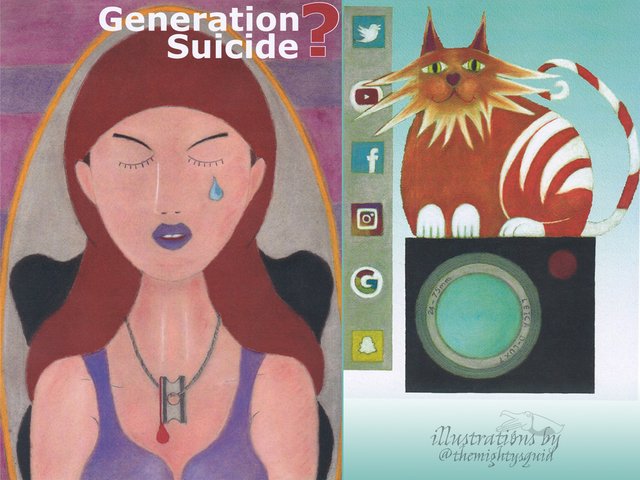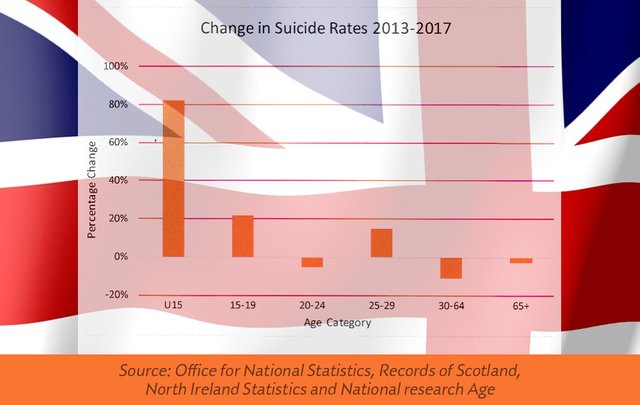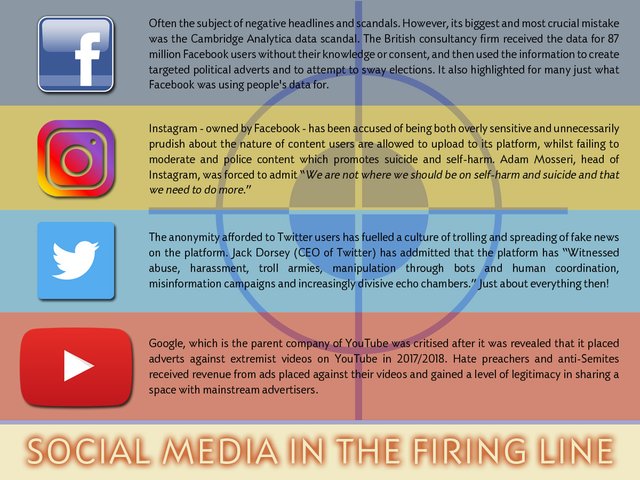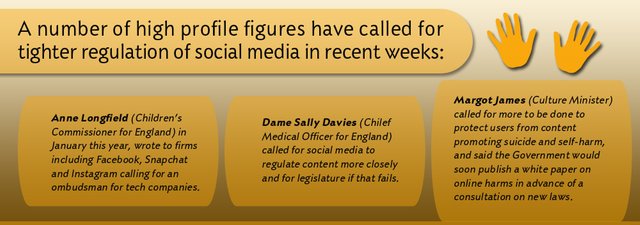Generation Suicide?
There has been a lot of debate in much of the press and amongst politicians recently regarding the deteriorating state of the mental health of our younger generation. In this article I explore some of the blame that has been directed towards social media and the tech sector and ask are we seeing the advent of Generation Suicide?

It is true to say that in the 15 years since Facebook has been operating there has been an epic shift in the way in which we communicate. The mental health charity 'Time to Change' recently conducted a study in which 5I % of the participants said that chatting to friends in "real life" is unnecessary because they are kept up to date on what people are up to via platforms such as Facebook, Instagram and Twitter. The study which looked at 5000 typical social media users also found that the average person now has 770 friends, yet 18% stated that they would not feel able to call on ANY of these 'friends' if they were struggling with mental health issues. It is estimated that around 25% of the population experience mental health problems each year. Time to Change concluded that the benefits (if any) from using social media is limited to surface level engagement, such as liking photos and comments, and that this is replacing more meaningful conversations both online and offline.
Recently, charities such as Childline have been reporting a complete shift in the problems which children are contacting them about. When Childline was launched in 1986, children contacted them largely to report harm or abuse done to themselves. According to the charity now many of them talk of mental health issues, about being suicidal, about life being not worth living; they are describing anxiety, depression, eating disorders and self-harm. With this in mind The Office for National Statistics (UK) released figures recently comparing suicide rates over the five years from 2013-2017. The results showed an alarming rise of 82% in the suicide rate in children under the age of 15. As can be seen in the table below there was also a rise of 22% in the 15-19 year old age range. The statistics for the last year of the figures (2017) showed that the suicide rate for teenagers (as a whole) for England was 5:100,000 and the same rate for Scotland was 9.9:100,000.

The discussion today now centres on whether it is social media which is driving this rise in the suicide rate amongst the younger generation or if the use of social media is symptomatic of something else. It is true that young people today are looking for answers and comfort on the internet in a way that the previous generations didn't or couldn't. They are looking for people who feel the way they do and, tragically, for some they are finding them. In many cases the solutions they are being offered are coping mechanisms which center on self-harm even to the point of suicide. Many commentators blame the big social media companies directly for the rise in teenage anxiety citing poor role models in the form of 'influencers' who are projecting an unachievable way of life to their millions of teenage followers. They also describe the trend for the younger generations need to seek affirmation online and to the rise of narcissism fuelled by likes, comments, retweets and the use of filters to produce unrealistic pictures. In many ways social media evokes a sense of ceaseless competition for status which promotes a world of false happiness in where we (and younger people in particular) risk fighting endless unwinnable status battles which is to the detriment of our mental health. In certain circumstances, if we are feeling low, using social media and seeing others fulfilled lives being portrayed can leave us hopelessly diminished.
We risk fighting endless unwinnable status battles which is to the detriment of our mental health.
Many young people have a positive and radically different relationship with social media than some commentators suggest. This is emphasised when you look at groups of young people with communication issues, disabilities or who are on the Autistic Spectrum. These groups often find direct communication difficult, unpleasant or even impossible. They often suffer from profound feelings of loneliness or isolation as a matter of course, perhaps because they have anxieties which they worry are unique to them. Social media with its innumerable groups and online communities gives them a chance to discover that they are not alone and to forge links transforming their lives. Perhaps it is in this specific positive attribute that social media embodies where the alternative negative problem can also be found.
A tragic example of this is Leilani Clarke. Leilani was 16 and described by her family as "artistic, hilarious, kind and beautiful with so much to live for". In February 2018 however, shortly after getting her GCSE results, Leilani logged into a suicide chatroom and killed herself in her bedroom. She had never been diagnosed with mental health problems and her parents and teachers had no clue that there was anything wrong with her. To all outward appearances Leilani was a normal teenager, not going partying or taking drugs and had a typical life, just choosing to spend time at home in her bedroom. After her death however her mother found the Instagram and Reddit threads she was following, they centred on suicide and self-harm. On the night she died she had been accepted into a suicide chatroom and had Googled self-harm and suicide. It was also discovered that her online friends were, as her mother Bonnie put it "a troubled bunch". Bonnie found an Instagram account Leilani had set up where she posted pictures of herself cutting her arms. Through Instagram she had made enquiries about a euthanasia drug on the dark web after being given the contact by a follower.
In another tragic incident 19 year old Zoe Watts took her own life after telling her family and a therapist that she planned to kill herself. Zoe, who suffered for several years with an eating disorder, was an intelligent and talented individual. She competed in trampoline at national level and had gained 10 GCSE's being accepted for study at two Universities. After her death her family discovered numerous Instagram accounts in which she had posted photographs of herself, one which showed herself crying with the message "l can't do this".·Other posts included "l am hopeless and selfdestruction is my only way of coping" and "maybe I am just not cut out for life and I will be like this forever a fat suicidal failure". Alongside these heart breaking posts Zoe's family saw the large number of hash-tags which linked to external sites encouraging Anorexia, self-harm and suicide. This was a common theme across all the social media platforms she was subscribed to including Facebook, Twitter, Snapchat and WhatsApp. On these platforms she was sent messages such as "don't worry about the hunger pains, that's your stomach applauding you for not eating" and advocating self-harm as being "good". Routinely Zoe was sent images of depression, suicide and self-harm.
"l am hopeless and selfdestruction is my only way of coping" and "maybe I am just not cut out for life and I will be like this forever a fat suicidal failure."
The most recent high profile case has been that of Molly Russell. Molly's tragedy may have proved a decisive tipping point towards a change of attitudes by the Government in relation to regulation of social media. Molly Russell was 14 and took her own life after being exposed to graphic images of self-harm and suicide on Instagram. Molly's father lan Russell said to the Sunday Times in an interview that Instagram "helped to kill my daughter". He went on to say (after seeing her social media accounts) "the more I looked, the more there was that chill of horror that I was getting a glimpse into something that had such a profound effects on my lovely daughter".
"Instagram helped to kill my daughter" Ian Russell
Despite the tragic cases stated, the most recent research conducted both here and in North America, suggests that the claims that we have "Generation Suicide" that has been ruined by social media and related technology are overwrought. Last month (Feb 2019) in Canada, research funded by Canada's Institutes of Health Research showed no evidence that social media use predicts depressive symptoms. The study which lasted for six years looked at both girls and boys, in school Years 6, 7 and 8 and concluded that: higher depressive symptoms predicted more social media use. However this was only true in the case of adolescent girls. Their findings goes against the ideas that are often so prevalent that people who use social media become more depressed over time. Instead, adolescent girls who are feeling down may turn to social media to try and make themselves feel better. In the UK a group of psychologists led by Amy Orben using data from 350 000 adolescents, reported that they found the use of digital technology was marginal in its adverse effect on mental health. Published in Scientific American the report's conclusions were described as "Technology use tilts the needle less than 0.5% away from feeling emotionally sound". For context, eating potatoes is associated with nearly the same degree of effect, and wearing glasses has a more negative effect on adolescent mental health. Of course scientific studies have none of the raw emotion of a family's account of the suicide of their child but must also be taken into consideration to avoid a knee jerk reaction which villainises social media in the round.
A recent 3 year study by Louis Appleby head of the National Suicide Prevention Strategy, looked into the cases of hundreds of youngsters who had killed themselves and found that 25% had visited websites where suicide was encouraged. He warned that general thinking about the effects and harms of social media lagged behind the reality of how teenagers are actually using it. Appleby stated "We have been looking at how much screen time youngsters have, which is a crude measure. It does not tell you anything about how young people are using screens". One of Appleby's conclusions was that we should be worrying less about how much time children spend on their phones and more about what they are doing on them. He went on to say,* "One worrying example would be if they are sending each other self-harm images. That runs the risk of self-harm spreading like some kind of contagion"*.

Where does social media go now?
In the wake of such tragedies, suddenly, the Government and others have decided that something should be done about social media. They are using the rise in adolescent suicide rates and a perceived impact on mental health, specifically around self-harm and low self-esteem, to push their agenda. Currently misters are considering major reforms that would classify social media companies as publishers and therefore make them legally responsible for the content of their websites and Apps. This move would have profound implications for social media companies and across the wider tech sector. Despite pressure in the past social media companies have consistently refused to take responsibility for content posted on their platforms, saying that they are not publishers of the material and therefore cannot take responsibility for the subject matter. The sector has largely been left to self-regulate which on the whole has not worked, despite the rise in numbers of online moderators and technological solutions such as Artificial Intelligence. It could be argued that self-regulation was always bound to fail due to the huge task required (the volume of data, the number of users and the amount of posted content / messages) and also due to the fact that self-regulation has not been effective in other self-harm forums such as gaming, gambling addiction, cyber bullying and grooming.

A recent meeting chaired by Health Secretary Matt Hancock and joined by senior Government figures including Damian Hinds (Education Secretary) and Anne Longford (Children's Commissioner) met with representatives from the biggest social media firms including Instagram, Google, Snapchat, Twitter and Pinterest to discuss current issues around self-harm and suicide. It was reported in the "i" newspaper that the tech companies were warned that there needed to be a "seismic shift" in responsibility or the matter would be taken out of their hands. Damian Hinds was also quoted in the Sunday Times (03-Feb-19) as saying that social media firms have a "moral duty" to act.
Ministers want to reclassify social media firms as publishers
Companies would become liable for the pictures and videos they distribute
Tech bosses threatened with direct legal action on themselves if they fail to remove content harmful to children.
Details of possible new legislation will be contained in a white paper due to be published shortly. As yet decisions on the possible sanctions and penalties that social media firms might face have yet to be made but the Suicide Prevention Minister, Ms Doyle-Price, indicated that social media executives could face arrest or prosecution for failing to police content on their platforms. In an interview Ms Doyle-Price was quoted as saying "nothing is off the table. We could use fines, we could make social media companies more responsible and apply the full force of the law to them if we feel that they are being negligent in their duty of care to their users".
In the past, tech giants have been able to side-step responsibility and any real sanctions because politicians did not fully understand the issues involved or because companies were able to exploit loopholes in laws which were framed in a different era. It would seem that opinion has turned and that a change is in the offing but is regulation and legislation of social media companies the answer to turn the tide on the rise of suicides and self-harm? Regulation may be part of the solution but a wider social change in attitudes is also required. With pre-school children spending an estimated four hours and sixteen minutes a day looking at screens and 70% of children aged 12-15 being allowed to take their phones to bed, our connected, tech driven new age is throwing up challenges faster than we can possibly 'fix' them with traditional thinking.
A fundamental reconfiguration of our relationship with social media is required but more importantly we need to understand the complex issues in why so many of our young people are resorting to self-harm and suicide, not just attribute it to the use of social media. The interaction with social media does have a part to play, however I personally doubt that any sort of regulation (however needed it may be) will lead to a dramatic fall in the tragic loss of life we have seen recently.
Not just social media it’s media in general. The movies, the games, shows, news. There is no window of opportunity like 30yrs ago when Jerry Springer was either at school time or late night. It’s 24/7 adult concepts bombarding 5-20yr olds. They are “switching” worlds of reality constantly. It’s like my comment here it is NOT the same as in person face to face to get All the nuances. Take a group of kids that are on media a lot vs those that aren’t. Who’s more well adjusted? Also another factor is children on prescriptions to alter behavior. This doesn’t just affect them it affects their peers that are not.
Congratulations @themightysquid! You have completed the following achievement on the Steem blockchain and have been rewarded with new badge(s) :
You can view your badges on your Steem Board and compare to others on the Steem Ranking
If you no longer want to receive notifications, reply to this comment with the word
STOPVote for @Steemitboard as a witness to get one more award and increased upvotes!